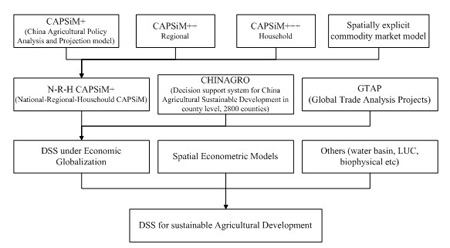New Development and Application of Economic Policy Analysis and Decision Support Systems in CCAP
The economic modeling team leaded by Prof. Jikun Huang in Center for Chinese Agricultural Policy (CCAP), Institute of Geographic Sciences and Natural Resources Research (IGSNRR) of Chinese Academy of Sciences (CAS), has been working on economic modeling, policy analysis and decision support systems (DSS) for more than 10 years. With their efforts in the last ten years, the team has been recognized as one of leading economic modeling groups in the world.
The primary goal of CCAP’s DSS is to facilitate scientific policy analysis and promote the sustainable development of China’s agricultural economy. DSS has been widely used by CCAP and its collaborators in policy analysis, simulation and projection. The system includes various partial and general equilibrium models at global, national, and regional levels (Figure 1). Each model of the system can be run independently or linked with other models in the system to enhance their analytical capacity.

Figure 1, models in CCAP’s economic modeling and decision support systems (DSS)
In recent years, a series of studies have been conducted based on the model system. Major studies include the following topics: 1) Analysis of the social economic effects of major trade policies (e.g., the impacts of China’s WTO accession, Doha trade liberalization, China and ASEAN free trade agreement, China and Australia free trade agreement etc); 2) Impact assessment of biotechnology (e.g., the effects of commercializing the genetic modified (GM) rice, cotton and maize in China, the impacts of import ban on China’s GM rice, and the global biosafety regulations on China’s agriculture etc); 3) Impact assessment of global and national biofuel development on agriculture, food security and poverty; and 4) Projections of commodity price, demand and supply with focusing on main agricultural products in short-run, middle and long run.
New models with detailed commodity classification at regional level are been developing. Meanwhile, the application of model system has been extended to many other research fields. Currently, China’s regional dynamic regional model (at provincial level) with “bottom-up” method and more sectors (137 sectors) is under development. More ambitiously, the spatial model at county level will be developed in the next following years to capture intra and inter economic links among regions. Based on the new developed models, CCAP’s DSS can be used to analyze the impacts of climate change, new energy policies and monetary policies (e.g., exchange rates and interest rate) and so on.
Download attachments: